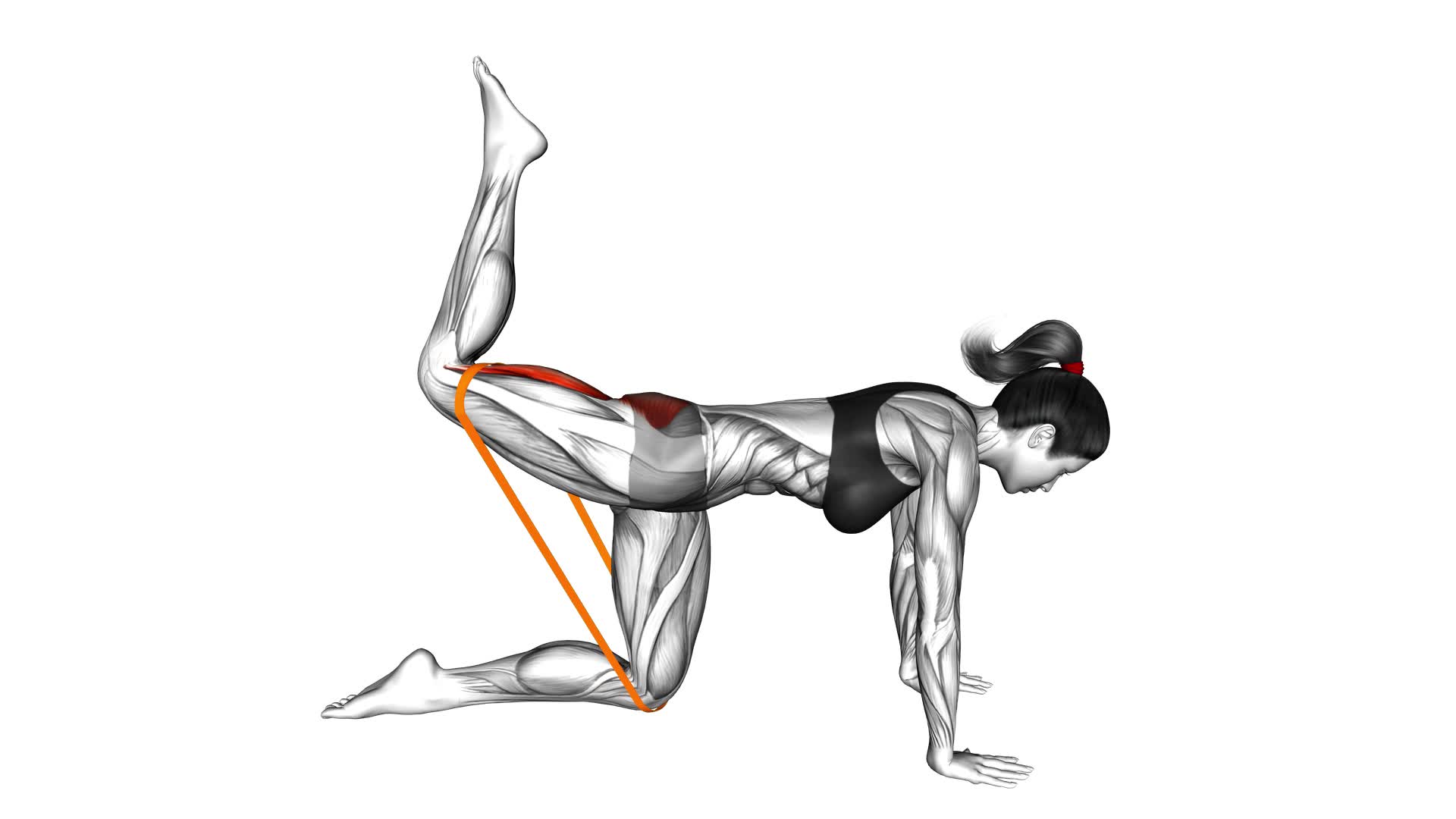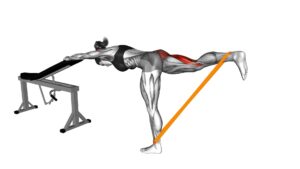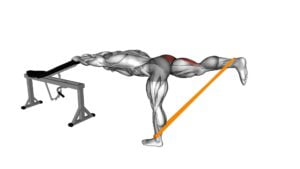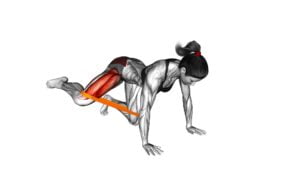Resistance Band Bent Leg Kickback (Kneeling) (female) – Video Exercise Guide & Tips

Are you looking for a quick and effective workout for your glutes? Look no further than the resistance band bent leg kickback!
Watch This Exercise Video
This exercise targets your glute muscles while also engaging your core.
In this video exercise guide, you'll find tips and techniques to perform this exercise correctly. Whether you're a beginner or have been working out for a while, there are variations and modifications for all fitness levels.
Get ready to feel the burn and strengthen your glutes with this powerful exercise!
Key Takeaways
- Resistance band bent leg kickback targets glute muscles and increases glute strength.
- Proper form and technique are important to prevent injury and maximize the effectiveness of the exercise.
- The exercise can be modified for different fitness levels by adjusting the resistance band or incorporating balance.
- To maximize the effectiveness of the exercise, focus on maintaining proper form, engaging glute muscles, and avoiding the use of momentum.
Benefits of Resistance Band Bent Leg Kickback
The Resistance Band Bent Leg Kickback is an effective exercise that targets your glutes and helps to increase glute strength. By incorporating resistance bands into this exercise, you can further enhance the muscle activation in your glutes.
The primary benefit of Resistance Band Bent Leg Kickback is the increased glute strength it provides. This exercise specifically targets the gluteus maximus, which is the largest muscle in your buttocks. By strengthening this muscle, you can improve your overall lower body strength and stability.
In addition to increased glute strength, the Resistance Band Bent Leg Kickback also engages other muscles in your lower body, including your hamstrings and quadriceps. These muscles work together to stabilize your hips and knees, helping to improve your balance and prevent injuries.
Another advantage of this exercise is that it can be easily modified to suit your fitness level. By adjusting the resistance band tension or the range of motion, you can make the exercise more challenging or easier, depending on your needs.
Equipment Needed for the Exercise
To perform the Resistance Band Bent Leg Kickback exercise, you'll need a resistance band. The resistance band is the key equipment for this exercise as it provides the necessary resistance to target and strengthen your glutes and hamstrings.
Here are some alternatives to using a resistance band for this exercise:
- Dumbbells: If you don't have a resistance band, you can use dumbbells as an alternative. Hold a dumbbell in each hand and perform the same kickback motion, focusing on squeezing your glutes at the top of the movement.
- Cable Machine: Another alternative is to use a cable machine. Attach an ankle cuff to the ankle furthest from the machine and position yourself facing away from the machine. With the resistance set appropriately, perform the kickback motion.
- Bodyweight: If you don't have any equipment available, you can still perform bent leg kickbacks using just your bodyweight. Get into a kneeling position and extend one leg behind you, squeezing your glutes as you kick back.
Proper Form and Technique
To perform the Resistance Band Bent Leg Kickback exercise with proper form and technique, keep your core engaged and maintain a neutral spine throughout the movement. This will ensure that you target the correct muscles and reduce the risk of injury.
One common mistake to avoid is arching your back or rounding your shoulders. This can take the focus away from your glutes and engage other muscle groups instead. To prevent this, imagine a straight line from your head to your tailbone and keep your shoulders relaxed.
Another mistake isn't fully extending your leg during the kickback. To maximize muscle activation in your glutes, aim to fully extend your leg and squeeze your glutes at the top of the movement. This will help to build strength and increase the effectiveness of the exercise.
It's also important to control the movement and avoid swinging your leg. Maintain a slow and controlled pace throughout the exercise to ensure proper muscle activation.
Variations and Modifications for Different Fitness Levels
To progress or modify the Resistance Band Bent Leg Kickback exercise based on your fitness level, try using different resistance bands or adjusting the intensity of the movement. Here are some variations and modifications you can consider:
- Varying Resistance Bands: Experiment with different levels of resistance bands to challenge yourself. Start with a lighter band and gradually increase the resistance as you get stronger. This will help you continuously improve your muscle strength and endurance.
- Adjusting Intensity: To make the exercise more challenging, you can increase the number of repetitions or slow down the movement to engage your muscles for a longer duration. Additionally, you can also use ankle weights or increase the tension of the resistance band by stepping on it with both feet.
- Incorporating Balance: To add an extra challenge and improve your balance, try performing the exercise while standing instead of kneeling. This will engage your core muscles and enhance your overall stability.
Remember to listen to your body and choose modifications that are suitable for your fitness level. Always prioritize proper form and technique to prevent injuries. By incorporating these variations and modifications, you can continue progressing and achieving your fitness goals.
Tips for Maximizing the Effectiveness of the Exercise
To maximize the effectiveness of the Resistance Band Bent Leg Kickback exercise, focus on maintaining proper form and engaging your glute muscles throughout the movement. By doing so, you can ensure that you're targeting the right muscles and maximizing your results.
One common mistake to avoid is using momentum to lift your leg. Instead, concentrate on using your glute muscles to lift your leg in a slow and controlled manner. This will place more emphasis on the targeted muscles and make the exercise more effective.
Another mistake to watch out for is arching your back or letting your hips drop during the movement. To maintain proper form, keep your core engaged and your back straight throughout the exercise. This will help to isolate your glute muscles and prevent strain on your lower back.
Additionally, make sure to choose the right resistance band for your fitness level. If the band is too easy, you won't be challenging your muscles enough. Conversely, if the band is too difficult, you may compromise your form and increase the risk of injury.
Frequently Asked Questions
How Many Calories Can I Burn by Doing Resistance Band Bent Leg Kickbacks?
You can burn calories by doing resistance band bent leg kickbacks. The exact number of calories burned will depend on various factors such as your weight, intensity of the exercise, and duration.
Resistance band exercises offer a range of variations that target different muscle groups and can help in burning calories. Incorporating these exercises into your workout routine can be an effective way to increase calorie burn and achieve your fitness goals.
Can Resistance Band Bent Leg Kickbacks Help Improve My Balance?
Resistance band bent leg kickbacks can indeed help improve your balance and stability. By engaging your core and targeting the muscles in your glutes and legs, this exercise challenges your body's ability to maintain control and control.
If you're looking for alternative exercises to further enhance your balance, you can try single-leg deadlifts, standing leg lifts, or yoga poses like tree pose or warrior III. These exercises will continue to challenge your stability and improve your overall balance.
Is It Safe to Perform Resistance Band Bent Leg Kickbacks if I Have Knee Pain?
Yes, it's safe to perform resistance band bent leg kickbacks if you have knee pain. However, there are modifications you can make to protect your knees.
First, try using a lighter resistance band or reducing the range of motion.
You can also perform alternative exercises like glute bridges or clamshells to target your glutes without stressing your knees.
Remember to listen to your body and stop if you experience any pain or discomfort.
Can I Incorporate Resistance Band Bent Leg Kickbacks Into My Cardio Routine?
Sure, you can definitely incorporate resistance band bent leg kickbacks into your cardio routine. They're a great way to target your glutes and hamstrings while also adding a cardio element.
If you're looking for alternative exercises, you can try standing kickbacks or donkey kicks. These exercises still target the same muscle groups and can be easily combined with other cardio exercises for a well-rounded workout.
How Often Should I Do Resistance Band Bent Leg Kickbacks to See Results?
To see results from resistance band bent leg kickbacks, it's important to consider the frequency of your workouts. You should aim to incorporate this exercise into your routine at least 2-3 times a week.
This consistent frequency will allow your muscles to adapt and grow stronger over time.
To track your progress, you can keep a record of the number of sets and repetitions you perform during each session.
Conclusion
In conclusion, the resistance band bent leg kickback is a beneficial exercise for targeting the glutes and hamstrings. It can be performed with minimal equipment and offers variations for different fitness levels.
By maintaining proper form and technique, individuals can maximize the effectiveness of this exercise. Incorporating the resistance band bent leg kickback into a regular workout routine can help strengthen and tone the lower body muscles.

Author
Years ago, the spark of my life’s passion ignited in my mind the moment I stepped into the local gym for the first time. The inaugural bead of perspiration, the initial endeavor, the very first surge of endorphins, and a sense of pride that washed over me post-workout marked the beginning of my deep-seated interest in strength sports, fitness, and sports nutrition. This very curiosity blossomed rapidly into a profound fascination, propelling me to earn a Master’s degree in Physical Education from the Academy of Physical Education in Krakow, followed by a Sports Manager diploma from the Jagiellonian University. My journey of growth led me to gain more specialized qualifications, such as being a certified personal trainer with a focus on sports dietetics, a lifeguard, and an instructor for wellness and corrective gymnastics. Theoretical knowledge paired seamlessly with practical experience, reinforcing my belief that the transformation of individuals under my guidance was also a reflection of my personal growth. This belief holds true even today. Each day, I strive to push the boundaries and explore new realms. These realms gently elevate me to greater heights. The unique combination of passion for my field and the continuous quest for growth fuels my drive to break new ground.







